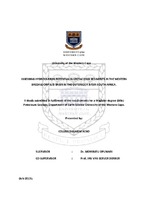| dc.description.abstract | The Bredasdorp Basin is one of the largest hydrocarbon producing blocks within Southern Africa. The E-M field is situated approximate 50 km west from the FA platform and was brought into commission due to the potential hydrocarbons it may hold. If this field is brought up to full producing capability it will extend the lifespan of the refining station in Mosselbay, situated on the south coast of South Africa, by approximately 8-10 years. This study is focused in block 9 off shore western part of the Bredasdorp Basin in the main Outeniqua Basin South Africa. Cretaceous Sandstone reservoirs are commonly heterogeneous consequently they may require special methods and techniques for description and evaluation. Reservoir characterization is the study of the reservoir rocks, their petrophysical properties, the fluids they contain or the manner in which they influence the movement of fluids in the subsurface. The main goal of the research is to assess the potentials of hydrocarbons in Cretaceous sediments in the Bredasdorp Basin through the integration and comparison of results from core analysis, production data and petrography studies for the evaluation and correction of key petrophysical parameters from wireline logs which could be used to generate an effective reservoir model for wells (E-BB1, E-BD2, EA01) in the Bredasdorp Basin. Porosity and permeability relationships, wire-line log data have been examined and
analysed to determine how the porosity and permeability influence reservoir quality which further influences the potential of hydrocarbon accumulation in the reservoirs. The reservoir sandstone is composed mainly of fine to medium grained Sandstones with intercalation of finger stringers of Siltstone and Shale. In carrying out this research the samples are used to characterize reservoir zones through core observation, description and analyses and compare the findings with electronic data obtained from Petroleum Agency of South Africa (PASA). Secondary data obtained from (PASA) was analysed using softwares such as Interactive Petrophysics (IP), Ms Word, Ms excel and Surfer. Wireline logs of selected wells (E-BB1, E-BD2, E-A01) were generated, analysed and correlated. Surfer software also used to digitize maps of project area, porosity and permeability plotted using
IP. Formation of the Bredasdorp Basin and it surrounding basins during the Gondwana breakup. The Bredasdorp Basin consists mainly of tilting half graben structures that formed through rifting with the break-up of Gondwanaland. The model also revealed that these faults segregate the reservoir which explains the pressure loss within the block. The production well was drilled, confining pressure relieved and pressure dropped hence production decreases. The age, transportation, deposition and thermal history of sediment in the basin, all plays a vital role in the type of hydrocarbon formation. Structural features such as faults, pore spaces determines the presence of a hydrocarbon in the reservoir. Traps
could be stratigraphic or structural which helps prevent the migration of hydrocarbons from the source rock to reservoir rock or from reservoir rock to the surface over a period of time. The textural aspects included the identification of grain sizes, sorting and grain shapes. The diagenetic history, constructed from the results of the reservoir quality study revealed that there were several stages involved in the diagenetic process. It illustrated several phases of cementation with quartz, carbonate and dolomite with dissolution of feldspar. A potentially good reservoir interval was identified from the data and was characterized by several heterogeneous zones. Identifying reservoir zones was highly beneficial during devising recovery techniques for production of hydrocarbons. Secondary recovery methods have thus been devised to enhance well performance. As recommendation, additional wells are required to appraise the E-M structure and determine to what extent the cement present in the basin has affected fluid flow as well as the degree of sedimentation that could impede fluid flow. There are areas still containing untapped resources thus the recommendation for extra wells. This research may well be reviewed with more data input from PetroSA (wells, seismic and production data) for additional studies, predominantly with respect to reservoir modelling and flow simulation. Based on the findings of this research, summary of calculated Net Pay shows that in well E-BB1, reservoir (1) is at depth 2841.5m – 2874.9m has a Gross Thickness of 33.40m, Net Pay of 29.72 and Pay Summary of 29.57 and reservoir (2) has depth of 2888.1m – 2910.5m, Gross Thickness of 22.40m, Net Pay of 19.92m and Pay summary of 1.48m. Well E-AO1 has depth
from 2669.5m – 2684.5m and Gross Thickness of 15.00m and has Net Pay of 10.37m and Pay Summary of 10.37m. Based on the values obtained from the data analysed the above two wells displays high potential of hydrocarbon present in the reservoirs. Meanwhile well E-BD2 has depth from 2576.2m – 2602.5m and has Gross Thickness of 350.00m, Net Pay of 28.96m and Pay Summary of 4.57 hence from data analysis this reservoir displays poor values which is an indication of poor hydrocarbon potentials. | en_US |

